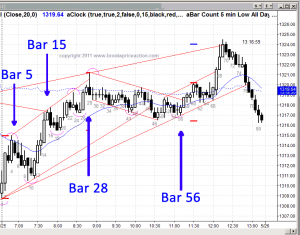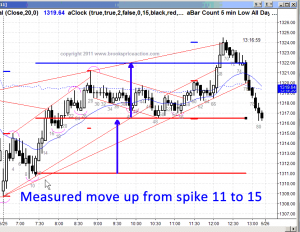BPA trading room Q&A: May 13, 2015 & May 25, 2011
Today’s Ask Al features two audio extracts on the topic of scalping. The first is taken from earlier this month where Al talks about the losing strategy of trading a 1 point profit target and 1 point stop strategy. The second audio is from the 2011 webinar vault! Here Al talked about what he looks for when going for 1 or 2 point scalps.
For convenience, both of the audio files are presented together below. Please scroll down for the transcripts and Al’s ‘funny little man holding a bag of money’! Enjoy.
Scalping and risking 1 point is a losing strategy (May 13, 2015)
Please comment on why 1 point scalping with stops, with a strict 1 point profit targets and stop losses may be a losing strategy over time.
Audio duration: 2min 09sec
What Al looks for when scalping 1 or 2 points (May 25, 2011)
From what I gather, four-point trades tend to be reversal setups, final flags, double tops, etc., and scalps for one point are a lot of different quick trades like selling the 17 or 30 highs for one point. Can you go over the key characteristics you look for in deciding to go for a two-point scalp versus a one-point scalp? Also, what is your stop loss in the two-point scalp?
Audio duration: 6min 58sec — Scroll down for images
Audio transcript #1 — May 13, 2015
Scalping and risking 1 point — A losing strategy
It really depends on what you’re doing. On a day like this, there are probably 20 stop-entry scalps for one point, but there were probably a whole bunch of other one-point stop-entry scalps that were losers. And to make money over time, scalping for one point, risking one point — if you do the math, if you’re just risking one point, you have to be right probably 60 percent of the time. However, if you’re only risking one point for a one-point scalp, then it’s hard to win 60 percent of the time because very often you’ll get an entry — let’s say a buy — and it pulls back but does not go below the low of the bar. It pulls back more than four ticks, so a lot of the trades will not go beyond the signal bar, but they’ll fall — they’ll come back four or five or six ticks.
So the math is really hard. I know it’s very appealing to try to minimize risk. When traders start out, their first thought is, “Oh, my gosh, I work so hard to get enough money to open an account. I really don’t want to blow this chance. This is my one big chance.” And the safest way, the most logical way for me to do this is to reduce my risk, so I have to use a very, very tight stop. However, when traders focus so much on one of the three variables, they don’t focus adequately on the others, and if a trader starting out is really concerned about risk, that means he’s probably not paying enough attention to probability, and that’s where traders lose money.
So they don’t realize just how important probability is, and most of the setups that you have during the day are 40 to 60 percent setups, and if you start going for one point scalp with a one point profit target, you have to be really good at picking all the 60 percent setups and avoiding the 55 percent setups and the 52 percent setups. And it’s just hard to do. Your margin for error is so small. Scalping for one point using a one-point stop, and just doing it with stop entries — you have to be perfect; you have to be really perfect, and I think that is unreasonable to expect from a person who’s starting out.
Audio transcript #2 — May 25, 2011
What Al looks for when scalping 1 or 2 points
I understand how you can conclude that based upon what I’m saying, and I talk a lot about that in the new books. Although it’s more often the case than not, it’s not always the case. [Also, what is your stop loss and two point scalp?]
Okay, let me deal with the easiest part first. In general, if the bars are around average size for a two-point scalp or a one-point scalp, I’ll use a two-point stop. In general, I prefer to take trades that I think are good for two points, and those are my main focus during the day. Some of them I think are going to be good for four points, and usually I’ll get out about half at two points and then half at four points. Sometimes, I’ll get out a quarter at one point, a half at two points, and then a quarter at four points.
Now, on the two-point scalp, I look for key swings. Could have tried to short below 5 for two points, but I was really looking to buy, so I thought the buy was a high probability buy, so I ended up buying below 10. I could have bought above 11. That would have been okay as well.
28, I think, was a reasonable short possibly for two points. The market could get down to the 18 low, but I was concerned that it may stall at the 24 low. 56, I thought was a great set up for two points. They turned it down at nine ticks, and when I saw the smallish entry bar at 67, the weak follow-through on 57, the weak follow-through on 58, 59, and then 10. 60 hitting my limit order several times and not filling, I quickly moved my limit order to one tick lower.
Four point trades
Let me go back to your first question. From what I gather, four-point trades tend to be reversal set-ups. That’s true; they tend to be reversal set-ups because you make four points or more, usually, you have to be at an extreme, which usually means the reversal. The point I was making earlier in the day that the spike up from 11 to 15 was so strong that it should go for a measured move up. If a trader bought the 14 close or even the 15 close, they probably had a 60 percent chance of making as many points as they had to risk.
So let’s look at the 15 close. So if a trader bought the 15 close, they were risking about five points or so, maybe more than five points — five-and-a-half points. I think there’s a 60 percent chance that they’ll make five points before their breakeven stop is hit. I have an entire section on the mathematics of trading in the new books, and I talk a lot about it. But anyway, that’s an example of if you’re a swing trader, you could be buying a breakout and have a good chance of making four points while risking four points, or making five points by risking five points.
In general, though, what you’re saying is correct. Most of the time when you’re expecting four points, you’re buying some kind of reversal. You want to argue that 11 is a reversal up rather than a bull flag, I think you can argue that. I did not short 70 because I thought it was a low probability for four points. I thought it was a relatively low probability for two points. I thought after the failed Low 2, the market would try to have a second push out. So I was looking to buy, but then we started to channel down and it never gave me a buy set-up.

In general, there are at least five decent trades a day that are good for two points. On an average day, there is usually a couple trades good for four points, and usually scalps — stop-entry scalps, usually at least 10, and limit-entry scalps, usually at least at 15 or so. In general, I take the scalps when they’re obvious. It’s like somebody’s handing out a bag of money saying, “Take this,” and I don’t want to say, “No, I’m looking for a two-point trade and I don’t want to get distracted.” A lot of times, I’ll just grab those little bags of money and put them in my pocket.
The basis of Al’s trading
What I look for all day long is trades that are good for two points and have a 60 percent probability. My risk is two points, my reward is two points, my probability is 60 percent. That is the basis of all my trading. And a lot of them are good enough for four-points, so sometimes you’ll hear me say, “Okay, I’m out at half or I’m out at three-quarters and I’m gonna let the remaining half or quarter go for four points.” That is what I mainly do all day long, but there are so many one-point scalps, I end up taking a lot of them and I can make a whole bunch of points on those one-point scalps. But that is not my focus; that is just that funny little man holding out a bag of money and offering it to me and I’m taking it. But I’m not out looking for those. I’m out looking for the two-point trades and the four-point trades.
In general, I want to buy above bull bars, like I want to buy above 11. I want to—if the trend is up, or I want to buy above 19 or I want to buy above 25, or above 56, or above 66. In general, if there’s clearly a strong trend, like there was from 1 to 28, I’ll only short below a really strong bear bar, like below 28. That would be okay.
Yes, the most profit potential takes place on reversal trades, but most of the reversal trades also have a lower probability. Like, I didn’t think of 70 as a high probability trade under the circumstances, but there’s a very big reward available even though it was probably a 30 percent chance of being reached. But it still pencils out, I’m sure, to be a decent swing short.
I thought it was higher probability that we would have two legs up, so I prefer to wait for the two legs up. My set-up never came, so I never took the trade that I was looking for — it never happened. And that’s okay, I look for high-probability trades because if I’m going for two points — risking two points, I have to have at least a 60 percent chance of success to even break even. So I’m always looking for high-probability trades.
Yes, most of the swings are low probability, 40 to 50 percent if you’re going to make four points. And I talk about this fairly regularly: that if you’re taking low, lower-probability trades, you pretty much have to take every one because if you cherry-pick, you’ll tend to pick all the bad ones and not pick the one good one that you need to make the strategy worthwhile. And then as an alternative, you can stick to higher probability trades and you don’t have to pick every one for the strategy to be profitable because everyone by itself has a profitable, mathematical expectation to it. You can just take those.
As far as taking the one-point scalps, the problem is knowing that the trade has a 70 to 80 percent probability of success. And that’s very hard to determine. And once you see a trade that you think has a 70 or 80 percent chance of success, it probably is a two-point set-up so you shouldn’t be scalping one point anyway. You should be going for two points.
Al Brooks
Information on Al’s Online day trading room



